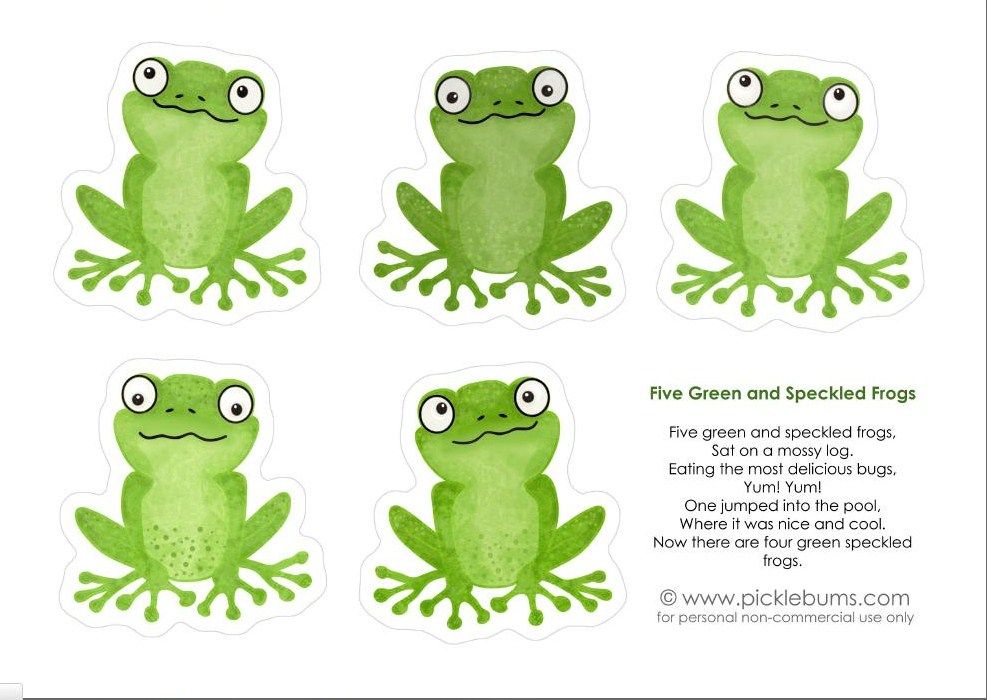Baby food guide pdf
Printable Baby Food Chart: BLW, Purees, Finger Foods
Make feeding your baby easier with this free, downloadable baby food chart. It has straight forward ideas for what to feed baby from when they start solids on up to one year—including purees, baby-led weaning style foods, finger foods, and more.
Baby Food Chart
Starting solids with a baby can be so fun and often a little challenging—but this baby food chart will help. I’ve compiled my best ideas for which foods to serve based on age and development of the baby to make it easy for you to make decisions in the kitchen.
This infant feeding chart is meant to help remind you of options you have at each age. It is not meant to add any pressure or function as a checklist of foods you have to serve (unless you want to do that!).
TIP: Download your free printable baby food chart here.
What baby foods should you start with?
Whether you start with purees or baby led weaning, starting with flavorful and nutrient-dense foods is a simple way to think about introducing foods to a baby. I love simple foods like roasted sweet potato, avocado, banana, and apple puree as first foods for a baby.
Remember that a first food is just that—a first food. It is not going to be the sole thing that determines how your child likes all foods. It can be sweet or savory, or from a variety of food groups. I would do your best to make sure that the food is easy to eat, has some flavor, and that the environment in which you offer it is free from pressure and, maybe even joyful!
What age should baby start eating foods?
The American Academy of Pediatrics recommends waiting to start solids until a baby is 6 months, and to go with wide variety of foods, introduced one at a time. But many pediatricians still say it’s okay to start rice cereal at 4 months.
If your pediatrician recommends this at the 4 month check up, ask their thoughts on the recommendation from the AAP.
TIP: Learn more about starting solids here.
How much food should I feed my baby?
The best way to know the right amount of food to give to a baby is to follow their lead. It should be very clear when a baby is done eating—they will close their mouth, turn their head, and generally make it very hard to feed them. (They may also play with their food, which is a fine way for them to interact with the foods at this early stage.)
It should be very clear when a baby is done eating—they will close their mouth, turn their head, and generally make it very hard to feed them. (They may also play with their food, which is a fine way for them to interact with the foods at this early stage.)
It’s okay if baby eats very little to start. It’s also okay if they surprise you by being very interested in food!
TIP: Download your free printable baby food chart here.
6 Month Baby Food Chart for Purees
If you’re ready to start solids with a baby, here are some foods you may want to start with. This list is perhaps more broad than you expect, but more recent research shows that it’s a good idea to introduce potential allergenic foods earlier and that lots of flavor is a great way to set baby up for eating a range of foods as they grow.
Don’t feel like you need to serve all of these foods (you 100% don’t!), but it should give you a range of ideas to consider based on season, availability, and your own preference.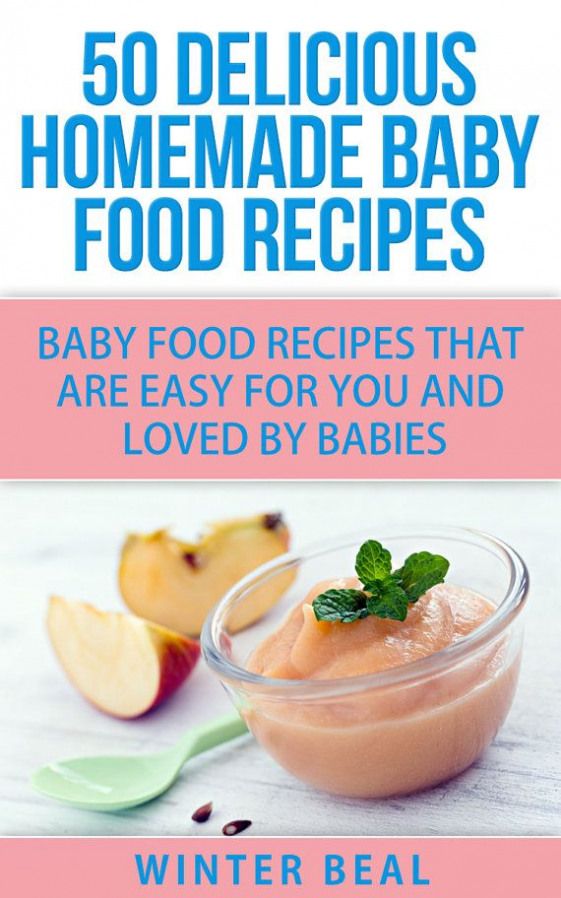
- Almond butter puree
- Apple Puree
- Avocado puree
- Banana puree
- Baby oatmeal
- Bean puree
- Butternut squash puree
- Egg yolk, hard cooked mashed with water
- Green bean puree
- Melon puree
- Pea puree
- Peach puree
- Peanut Butter Puree
- Pear puree
- Pumpkin puree
- Sweet potato puree
- Whole milk plain yogurt
- Single ingredient baby food
TIP: Find more in depth details on how to know if your baby is ready to start solids here.
6 Month Baby Food Chart for Baby Led Weaning
If you decide to use the baby led weaning method of feeding, you’ll want to cut these foods into the shape of a finger or larger. The foods should also be soft and easily squishable between two fingers—like the texture of a roasted sweet potato wedge or ripe avocado.
You don’t need to feel like you have to serve all of these foods by any means, but it should give you a range of ideas.
- Apple, roasted wedge
- Avocado spears
- Banana
- Beef, ground (large piece)
- Beef hamburger patty (sliced)
- Beet, steamed or roasted
- Broccoli florets, roasted/steamed
- Cauliflower florets, roasted/steamed
- Chicken, dark meat shredded
- Cucumber
- Green bean
- Egg, hard cooked
- Egg in omelet, sliced
- Figs, halved
- Lamb
- Mango slice
- Meatball
- Melon slices
- Peach, very ripe slice
- Pear, very ripe slice
- Potato, roasted wedges
- Steak slice
- Sweet potato, roasted wedges
- Toast with mashed avocado
- Toast with mashed sweet potato
- Toast with light smear of peanut butter
- Toast with mashed hard cooked egg
- Watermelon slice
- WiId salmon
TIP: Find my Ultimate Guide to Baby Led Weaning here.
7 Month Baby Food Chart
With a 7 month old baby, you can add in a few more foods including those with more acid like citrus.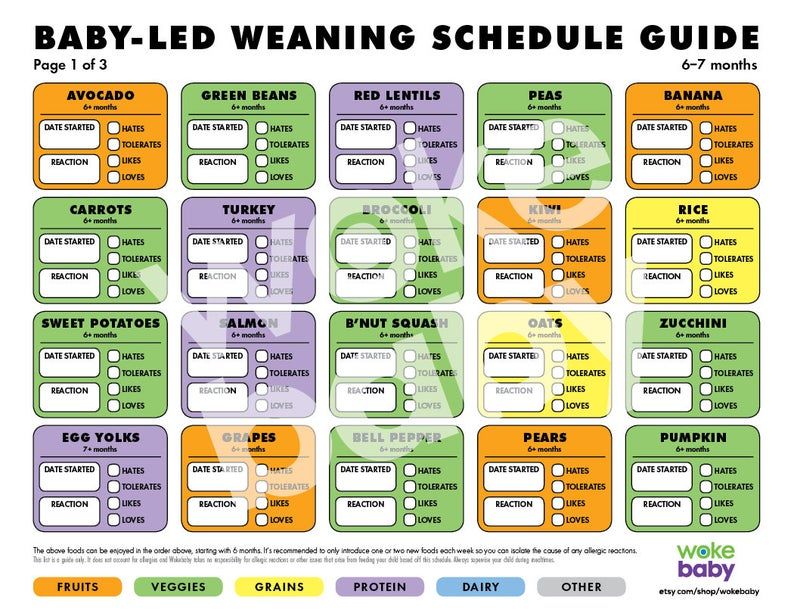 Continue serving the foods on the 6th month list, or introduce ones that you didn’t get to in that first month.
Continue serving the foods on the 6th month list, or introduce ones that you didn’t get to in that first month.
- Baby rice crackers
- Bean puree
- Beet puree
- Brussels Sprouts, pureed (or large piece for BLW)
- Guacamole
- Kiwi puree (or large piece for BLW)
- Hummus
- Mango Puree
- Mixed ingredient baby foods
- Orange segment for BLW
- Pineapple puree (or large piece for BLW)
- Prune puree
- Strawberry puree (or large strawberry for BLW)
- Spinach puree
- Smoothies (simple)
- Tomato sauce
- Tomato sauce with ground meat
TIP: Try my 10 easy No Cook Baby Foods.
9 Month Baby Food Chart
As a baby nears the 9 and 10 month mark, they will begin to be able to pick up small, pea-size pieces of foods with their fingers. This development of the “pincer grasp” means they are ready to start sampling table foods.
A good rule of thumb is to cut foods to about the size of a pea and to serve them very soft and easily squishable between your fingers.
Bread-like textures in foods like pancakes and muffins may be difficult for your child, so you may want to moisten them with water, applesauce, yogurt, breastmilk, or formula.
Remember that babies learn to eat a variety of paces, so follow the lead of your baby and avoid pressuring them to eat foods or amounts of foods that they aren’t ready for. If a baby turns their head away, closes their mouth, shakes their head, or cries, they are done with food and it’s okay to end the meal.
Continue serving foods from the previous months. And try adding:
- Banana, diced and mashed slightly as needed
- Barley, cooked until very soft
- Beans, slightly mashed
- Beef, ground
- Blueberries, diced
- Cheese, shredded
- Chex cereal
- Chia seed in smoothies, yogurt or oatmeal
- Chicken, ground
- Chicken, shredded and chopped into small pieces
- Clementines, diced (you may want to remove the slightly tough membrane)
- Cottage cheese
- Corn
- Flaxseed in smoothies, yogurt or oatmeal
- Goat cheese, soft crumbles
- Grapes, diced (never whole)
- Kefir, plain
- Meatball, diced
- Muffins, diced (moistened if needed)
- Millet
- O cereal
- Oatmeal
- Overnight oats
- Pasta
- Peas
- Potatoes, roasted or mashed
- Puffs
- Raspberries, diced
- Pancake, diced (moistened as needed with applesauce)
- Quinoa
- Rice
- Salmon, small pieces
- Tofu, diced
- Tomatoes, fresh
- Tilapia, small pieces
- Turkey, ground
TIP: Find my best Early Finger Foods, which will cover this stage and early toddlerhood.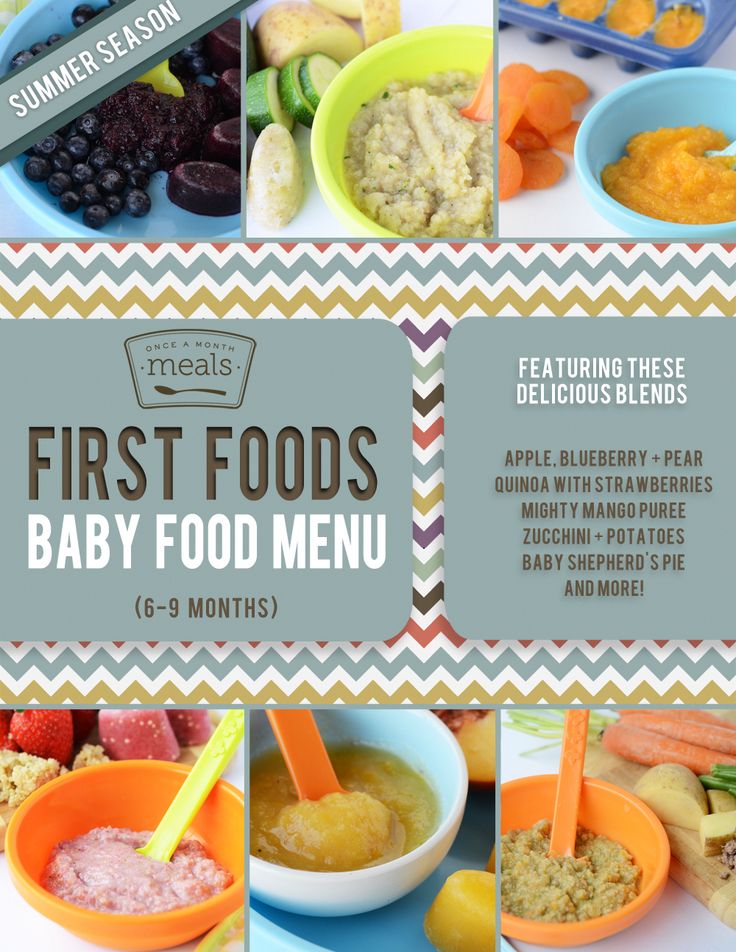
Best First Finger Foods for Baby
I put together my go-to first finger foods for babies, which may help you narrow down which foods to start with. Each of these is a nutritious whole food that’s soft and easy for baby to eat. It’s helpful that many of these foods are ones that us grownups like too, so it should make meal planning and prep for the little ones easier on you!
Printable Baby Food Chart
Grab your free copy of my downloadable Baby Food Chart with access to my entire Resource Library of Printable charts by signing up for my newsletter.
You May Also Like
- ABC Baby Muffins
- Master List of Baby Snacks
- Extra-Veggie Baby Soup
- Sweet Potato Teething Biscuits
- Master List of Baby Food Recipes
I’d love to hear your feedback on this chart, so please comment below! I always love to hear from you guys.
This post was first published Jan 2019.
6 months baby food chart with baby food recipes
By Swasthi on August 6, 2022, Comments,
6 months baby food chart with baby food recipes. The best time to start solids for babies is after 6 months. There are many sources suggesting introduction of solids from 3 to 4 months. But an early introduction of solids can lead to more colic, digestive troubles and allergies.
The best time to start solids for babies is after 6 months. There are many sources suggesting introduction of solids from 3 to 4 months. But an early introduction of solids can lead to more colic, digestive troubles and allergies.
A baby develops digestive enzymes in between 4 to 6 months which are crucial for digestion of foods. It is a good choice to wait until the baby develops these enzymes completely.
A baby typically begins to develop head control from 3 to 4 months and gains strong head to neck muscles by 6 months. A strong head to neck control helps the baby to accept solids well and can easily swallow.
So by 6 months a baby has a better digestive system and a good head control which are needed before the introduction of solids.
Breast milk is the best bet for the overall growth of a baby. It is recommended to exclusively breast feed a baby for the first 6 months.
As an exception, formula milk is an alternate for women who cannot breast feed baby due to professional, personal or medical reasons.
If you have a baby older than 7 months, you can follow this complete
baby food chart for 8 months old and above
How do you know your baby is ready for solids?
1. The baby’s head & neck are stable. This means baby can accept food and swallow.
2. Baby must be able to sit stable with or without support.
3. Shows interest in food when others are eating.
4. Baby must be able to open the mouth when food is offered.
5. Baby is still hungry after breastfeeding or formula feed.
Tips on how to start solids for baby
First consult your pediatrician to confirm if your baby is ready for solids. It is very important to plan well before you introduce any other foods apart from breast milk.
Make your own feeding schedule along with the foods you intend you try and get an approval from your pediatrician. Most clinics and hospitals also provide a diet chart or at least a guide.
I have made this from the guidelines I got from the Clinics here in Singapore. I have followed the same for both my babies.
I have followed the same for both my babies.
1. Always start with a single food. Either a fruit, vegetable or grain. Avoid a mixture of foods. You can start with mashed fruit first. The presence of digestive enzymes in fruits helps the baby to digest them better.
2. After a week, while you continue feeding fruit, you can start rice water (kanji), after a week clear dal soup or boiled vegetable broth / water.
3. Always follow the 3 day wait rule for every food you introduce. Wait for the results until the 4th day. Please see the doctor immediately if your baby develops rashes, runny nose, watery eyes, colic etc.
4. Introduce new foods to your baby during breakfast or lunch. Avoid trying new foods during the later time of the day as it is easy to get a control over the problems.
5. A 7 month old baby can eat only a tsp of mashed food initially. Slowly by 4 weeks increase the quantity to a tbsp and then more.
Helpful tips – introducing solids for baby
1. Use stainless steel or glass bowls and cups for preparation of baby foods. Avoid plastic ware even made of any superior material, including virgin plastic or graded as BPA free. Any kind of plastic ware consists of plasticizers that are used to make the containers flexible.
Use stainless steel or glass bowls and cups for preparation of baby foods. Avoid plastic ware even made of any superior material, including virgin plastic or graded as BPA free. Any kind of plastic ware consists of plasticizers that are used to make the containers flexible.
Plasticizers are similar to BPA and are an endocrine disruptor. Even BPA free plastic and virgin plastic ware have chemical plasticizers. Please use google search for more info.
2. Always feed the baby in a calm, quite environment and in a steady place like – on the lap, in a high chair or on the floor.
3. While feeding, refrain the baby from activities like watching a TV show, playing with a hand held gadget like mobile, and tablet or game devices. Some of these emit radiation that is not good for the baby.
4. Meal time has to be a learning for the baby, speaking to your baby about the food – its texture, taste and color helps the baby to develop a liking for the food. Or narrate a good story to the baby, do not encourage the baby to talk while eating. This may seem to be over disciplined but this is the only way i have found to grow fuss free kids. They will begin to love any food that is served.
This may seem to be over disciplined but this is the only way i have found to grow fuss free kids. They will begin to love any food that is served.
5. Introduce water from a steel cup or a glass not from a feeding bottle or sipper. A 90 ml cup is best suited. This makes the transition from teat to cup easy when the baby grows up.
6 months baby food chart
To follow this baby chart please ensure your baby has completed 6 months and you have an approval from your pediatrician for the same.
A baby usually consumes milk every 2 to 3 hours. Solids should be served in between the feeds. Use plain boiled and cooled water to puree the fruits if needed. Avoid mixing milk or any other ingredient with fruit.
The combination of fruit and milk products results in indigestion, loss of appetite, no weight gain and accumulation of toxins.
Clear soups can be used to make pureed rice, oats or ragi cereal. Feeding only clear soups regularly is not a good idea as they lack the nutrition that is provided by a semi solid food or milk.
I have shared a sample baby food chart below which shows the quantities of fruits and vegetables. From the chart (day 13 to day 20), you can replace potato with rice porridge (kanji) or dal soup or ragi porridge.
This is an alternate table which you can follow if your baby is in between 6 and 7 months.
| Breastfeed or formula milk. What ever time your baby wakes up. |
7.30 to 8 am fruit puree |
| One of the following: (only after 1½ to 2 hours of milk). You can use boiled cooled water to thin down the puree. 1. Banana- mash with a fork or run in a blender. 2. Apple- peel,core,steam for about 5 to 6 minutes. Puree in a blender 3. Chickoo (sapota)- mash with a fork and spoon 4. Pear- peel and core, steam for 5 to 6 minutes 5. Papaya – mash with a fork or blend 6. Ripe avocado – add it to a blender and puree |
11.  30 to 12.30 pm 30 to 12.30 pm |
| After introducing fruits, you can try these. Continue to feed fruits for breakfast. first 1 week – rice cereal 2nd week apple rice or rice cereal with boiled carrot 3rd week ragi porridge Or apple ragi or oats porridge Or apple oats Or clear moong dal soup 4th week – Repeat the foods mentioned above. You can also introduce soupy khichdi. You will have to make it following the same method I mentioned for rice cereal above. |
| Breast feed or formula (only after 1.5 to 2 hours of lunch) |
Baby food recipes for 6 months old along with ingredients and instructions to prepare
These are the quantities i followed for my kids i got from the Health Promotion Board,Singapore.Use any one
Quantity of fruits for 6 months to 9 months
½ small apple
½ small pear
½ cup sapota
½ cup papaya
½ medium banana
How many times can the same fruit be given in a week?
Including a variety of fruits will provide different kinds of nutrients to the baby.
Banana – 3 to 4 times
Apple – daily
Chickoo- daily
Pear- 3 to 4 times
Papaya – 4 to 5 times
Avocado- 3 to 4 times or daily
Do read the complete post before you attempt any of these recipes
More tips on preparing Lunch
from 3 rd week – Rice, ragi or oats. Clear dal soup with veggie.
first 7 days (from 3rd week) -Single grain with milk (formula or breast milk). You can also use gluten free or baby oats or ragi to make porridge.
next 7 days – Rice with a single veggie or apple. You can use steamed or boiled carrots.
VEGETABLES to prefer
1. carrots
2. pumpkin
LENTIL/ DAL to prefer
1. moong dal
2. toor dal
About Swasthi
I’m Swasthi Shreekanth, the recipe developer, food photographer & food writer behind Swasthi’s Recipes. My aim is to help you cook great Indian food with my time-tested recipes. After 2 decades of experience in practical Indian cooking I started this blog to help people cook better & more often at home. Whether you are a novice or an experienced cook I am sure Swasthi’s Recipes will assist you to enhance your cooking skills.
Whether you are a novice or an experienced cook I am sure Swasthi’s Recipes will assist you to enhance your cooking skills.
Follow Swasthi’s Recipes
Sign up to receive awesome Swasthi’s Recipes in your inbox *
Popular Recipes
Featured Recipes
Nutrition in kindergarten
Dear parents!
In GBDOU kindergarten No. 68, from March 1, 2021, changes have been made to the cyclic ten-day menu.
Organization of hot meals in kindergarten is carried out in accordance with the current nutritional standards, regulations of the Russian Federation and St. Petersburg on the organization of nutrition for preschool children, the requirements of legislation in the field of sanitary and epidemiological welfare of the population. Products are supplied by LLC "Artis - Baby Food", JSC "Firm Floridan", LLC "TD "Leningradsky". nine0003
nine0003
- A cyclic ten-day menu is used to organize meals for children aged 2 to 3 years attending preschool educational institutions in St. Petersburg, in accordance with the physiological norms of food consumption;
- A cyclic ten-day menu is used to organize meals for children aged 3 to 7 who attend preschool educational institutions in St. Petersburg, in accordance with the physiological norms of food consumption. nine0010
The nurse daily monitors the quality and compliance with nutritional standards.
Meals for children - 4 meals a day.
- Breakfast
- Second breakfast
- Lunch
- Snack
Officials of the Social Food Administration
| Position | Full name nine0039 | Phone |
| Head of the Department of Social Nutrition | Mironenko Alena Vladimirovna | 576-53-24 |
| Deputy Head of Department | Petrova Natalia Valentinovna | 576-53-28 |
| Deputy Head of Department - Head of Economic Analysis and Management Department | Zinkovsky Yuri Valerievich | 576-53-26 |
| Head of Technology, Standardization and Control Department | Gaponova Olga Mikhailovna | nine0002 576-68-25 |
| Head of financial and accounting department - chief accountant | Rumyantseva Marina Mikhailovna | 576-68-55 |
Personal reception of citizens and representatives of enterprises and organizations in the Department of Social Nutrition:
Head of Department - Tuesday from 10-00 to 12-00; Thursday - from 16-00 to 17-00; nine0003
Deputy Head of Department — Monday from 16:00 to 17:00; Wednesday from 10-00 to 12-00;
archival specialist - Monday, Wednesday, Friday from 11:00 to 16:00
hotline: 576-68-13
Regulatory documents:
Law of St. Petersburg dated 08.10.2008 N 569- 95 "On social nutrition in St. Petersburg"
Petersburg dated 08.10.2008 N 569- 95 "On social nutrition in St. Petersburg"
Ten-day menu 1-3 years
Ten-day menu 3-7 years
Local acts of the institution:
Ten-day menu Garden
Ten-day menu Nursery
Recommended average daily food intake. in preschool organizations
Order No. 49 "On Catering"
Regulations on the Nutrition Council
Order No. 48 "On Approval of the Work Plan of the Nutrition Council 2022 - 2023"
Regulations on the Marriage Commission on Nutrition 9003 on the commission for monitoring the organization and quality of food, the rejection of finished products
Order No. 50 "On the establishment of a marriage commission."
Order No. 47 "On approval of the composition of the Nutrition Council"
Order No. 80 "On the organization of meals for children in the short stay group"
Order No. 81 "On approval of the menu for the short stay group"
Catering
Andreeva Ksenia Dmitrievna
Teacher
tel: +7 (812) 246-1898
Food for students is provided by Joint Stock Company "Artis - Baby Food". nine0029
nine0029
General Director of Joint Stock Company "Artis - Baby Food" ̶ M.V. Lyasko
There is no dietary menu in the gymnasium.
174.14 KB (pdf)" >
Meal Application Form (pdf)Menu:
- 776.52 KB (pdf)" > Daily menu (pdf) nine0010
- 3.16 MB (pdf)" > Cyclic menu for elementary school students (pdf)
- 2.72 MB (pdf)" > Cyclic menu for high school students (pdf)
Local acts:
- 1.
 09MB (pdf)" > Canteen visit schedule (pdf)
09MB (pdf)" > Canteen visit schedule (pdf) - 988.34 KB (pdf)" > Regulations on catering (pdf)
- 962.97 KB (pdf)" > Regulations on the Nutrition Council (pdf) nine0010
- 545.98 KB (pdf)" > Regulations on the drinking regime (pdf)
- 1.35 MB (pdf)" > Healthy Eating Program (pdf)
- 635.35 KB (pdf)" > nine0226 Regulations on parental control over catering for students at Gymnasium No.
 49 (pdf)
49 (pdf) - 636.00 KB (pdf)" > Regulations on the procedure for access of members of parental control to the dining room of GBOU gymnasium No. 49 (pdf)
- 1.41 MB (pdf)" > nine0226 Parental control. May 2022 (pdf)
- 317.76 KB (pdf)" > Minutes of the meeting of the Nutrition Council dated 30.08.2022 (pdf)
- 364.49 KB (pdf)" > Minutes of the meeting of the Nutrition Council of 12.09.2022 (pdf)
- 2.
 71 MB (pdf)" > Minutes of the meeting of the Nutrition Council dated 29.09.2022 (pdf)
71 MB (pdf)" > Minutes of the meeting of the Nutrition Council dated 29.09.2022 (pdf)
Federal and state regulations:
- 3.32 MB (pdf)" > SaNPin (pdf) nine0010
- 23.56 MB (pdf)" > Standard for the provision of services for providing hot meals in OS (pdf)
- 353.53 KB (pdf)" > Government Decree on the cost of food No. 253 dated 03/28/2022 (pdf) nine0009 571.08 KB (pdf)" > Decree of the Government of St.
- 571.08 KB (pdf)" > Order of the Education Committee of the Government of St. Petersburg No. 2595 dated 12/30/2020 (pdf) nine0009 2.52 MB (pdf)" > Law of St. Petersburg "On Amendments to the" Law of St. Petersburg "Social Code of St. Petersburg" dated 03.06.2020 (pdf)
- 6.13 MB (pdf)" > Decree of the Government of St. Petersburg No. 928 dated 10.10.2022 (pdf) nine0010
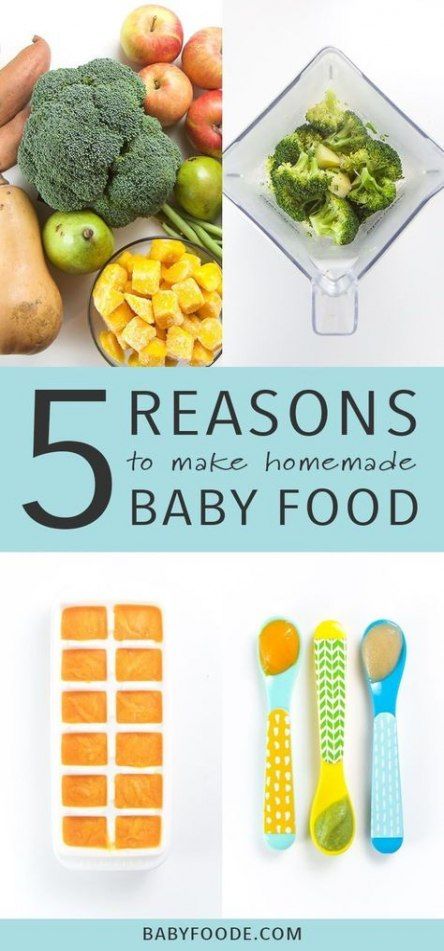 Petersburg dated 05.03.2015 No. 247 (pdf)
Petersburg dated 05.03.2015 No. 247 (pdf) - Rospotrebnadzor hotline: 8-800-100-0004
- Information and reference telephone line of the Office of Rospotrebnadzor for the city of St.
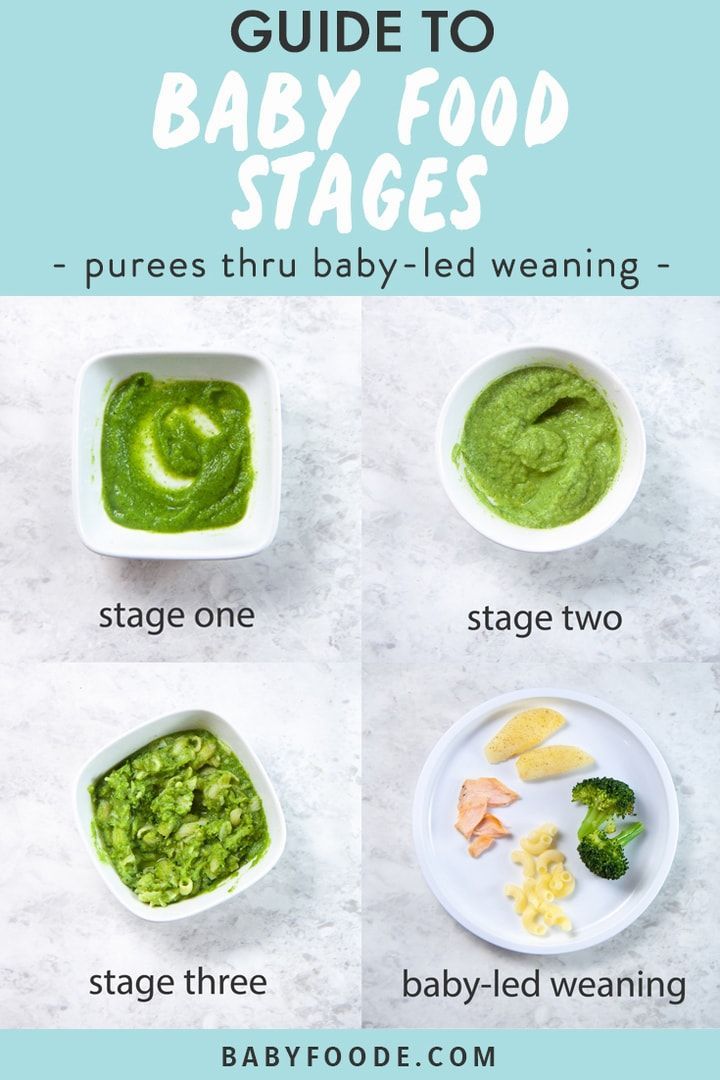 Petersburg: 8-812-712-29-81
Petersburg: 8-812-712-29-81 - Hotline of the Social Nutrition Department of St. Petersburg: 8-812-417-35-70 nine0010
- It will be possible to ask questions and report violations around the clock through the WhatsApp and Telegram mobile applications by phone +7-931-326-68-07
- Website of the Hotline of the Department of Social Nutrition of St. Petersburg
- Hotline for providing meals in educational institutions: 409-83-90
- tel.: 417-42-06 - chief specialist of the education department Norchinskaya N.L.
- tel.
 : 8-981-722-53-39 - food curator from the company "Floridan" Shkutova E.I.
: 8-981-722-53-39 - food curator from the company "Floridan" Shkutova E.I.
Nutrition activities
- 905.95 KB (pdf)" > nine0226 12/14/2022 Children's drawing competition "Healthy Eating. Milk Day." (pdf)
- 398.96 KB (pdf)" > 12/07/2022 Exhibition of drawings “Healthy eating. Fruit Day" (pdf)
- 1.57 MB (pdf)" > 30.11.22 "Poster exhibition ,Healthy Eating. Vegetable Day." (pdf) nine0010
- 1,013.10 KB (pdf)" > 11/25/22-DRAWING competition "Healthy Eating" for students in grades 1-9 (pdf)
- 286.









